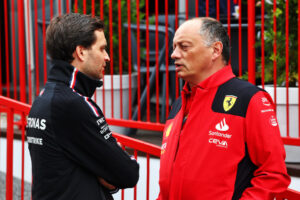This weekend’s Grand Prix of Long Beach marks 40 years since Indy cars made their debut on the So-Cal street circuit. A milestone that will be celebrated with 18 vintage Indy cars roaring on track throughout the weekend. The significant anniversary was also saluted in the latest issue of Vintage Motorsport (April/May) with Editor David Malsher-Lopez detailing the switch from Formula 1 to Indy cars in 1984 and the driver that stole the show – Mario Andretti.

If you were a West Coast fan of Formula 1, it was disquieting in the early 1980s to learn of the struggles the Grand Prix Association of Long Beach was facing in trying to keep the world’s premier open-wheel series returning to the Southern California port city’s streets. Chris Pook, event co-founder, discovered F1 supremo Bernie Ecclestone was ramping up sanction fees year on year in a manner that couldn’t be recouped by event investors and ticket sales.
BUY THIS ISSUE | SUBSCRIBE TO VINTAGE MOTORSPORT
In Gordon Kirby’s book, “Chris Pook & The History of the Long Beach GP,” he recounts, “Bernie was continuing to kill us on price. We were up to $1.75m for Bernie plus a bunch of other listing fees and so forth. The total was close to $2m. And after the 1983 race we would be faced with paying Bernie $2.1m… If we had one rainy weekend, we could be back in the red again. So we introduced the concept of CART Indy cars to the City…
“Finally we talked to Toyota [event sponsor] about CART… Eventually Toyota’s American bosses said they and their dealers really loved the idea and thought it would be good for them to have a field of American drivers.”
The difference in price? A hefty $1.6m.

It’s reassuring to be reminded that rolling starts at Long Beach have always looked messy. Photo: Grand Prix Association of Long Beach
Jim Michaelian, then GPALB’s financial controller but now its president and CEO, recalls: “Despite pulling in huge crowds and having good sponsorship, we weren’t making any money. Even City officials were urging us to think about what size risk we were taking for how little reward. Chris and I flew to New York for dinner with Bernie; he was reluctant to move from a fairly substantial sanction fee increase for 1984, and we couldn’t see a way of making it work for us, our sponsors and investors. That’s when we started speaking with CART president John Frasco.
“Was there a concern about switching from Formula 1 to Indy cars? Yes, we recognized that in the first year or two running Indy cars, we’d probably draw less than we had for F1. But given the marked decrease in sanction fee, we could still make the event profitable.”
There was no way to avoid the initial perception from race fans that the event had taken a step down in importance. Team Penske, Newman/Haas Racing and Truesports, however great they were, could never have the cachet of marques prominent in Formula 1, such as Ferrari or Lotus.
Says Michaelian: “The challenge was to present the ‘84 event in a way that closely correlated to the experience people had here in previous years. Don’t forget, with a street circuit, especially ours, the attraction was the overall experience – no single race, no single concert. When someone left this venue on Sunday evening, what kind of experience would he or she reflect upon?
“We felt strongly that the people who were entertained by a variety of aspects at the event would return, and race fans would come to see how Indy car looked in comparison. Plus it was the first round of the 1984 CART season, which added a bit of cachet. But anyway, we could tolerate a slight decrease in attendance because of the substantial reduction in the sanctioning fees.”
BUY THIS ISSUE | SUBSCRIBE TO VINTAGE MOTORSPORT
If the chassis (the majority of them March) and engines (the vast majority Cosworth DFX turbo V8s) weren’t going to lure in the car geeks, there were drivers familiar to F1 fans. Two-time world champion Emerson Fittipaldi was restarting his career after premature retirement in 1980, and there was Teo Fabi, Roberto Guerrero, Brabham (Geoff, eldest son of Sir Jack), Villeneuve (Jacques, brother of the much missed Gilles, 1979 Long Beach winner), Derek Daly, Bobby Rahal, Danny Sullivan, Bruno Giacomelli, Kevin Cogan…
But the presence guaranteed to get fans through the gates was one Mario Andretti.

“The lead name who had the greatest effect was Mario, no doubt about it,” says Michaelian. “He starred in the first grand prix here, the Formula 5000 race in 1975, and then he won the F1 race in ‘77, which was a huge turning point in the history of this event – an American driver winning an American race, but on the world stage. That got us a lot of exposure. So to have him return here in 1984 as an Indy car driver was huge in our transition – and beyond.”
And Andretti himself was thrilled to return to a venue he hadn’t expected to revisit once he’d quit F1 completely. He saw it very much as a feather in CART’s cap.
BUY THIS ISSUE | SUBSCRIBE TO VINTAGE MOTORSPORT
“I welcomed that like you can’t believe!” he says. “We had plenty of road courses mixed in with the ovals by then, but the only other temporary track on the schedule at the time was Caesars Palace in Las Vegas. Now here was a true street circuit, and that helped push the idea that Indy car Racing demanded a driver to be diverse in his skills. A street courses requires a very different discipline to a natural road course.”
It mattered not that the track had been temporarily reduced from 2.035 miles to 1.67 by shortening the international hairpin and deleting the pre-pit entry chicane. But this was Indy car Racing’s first true street race since 1933 – and it showed. Having experienced the course in F5000 and F1 cars, Andretti admits an Indy car felt slightly cumbersome between the concrete blocks and tire walls.
“That’s just the nature of the beast, always had been,” he shrugs. “When I first tried a Formula 1 car at Monza in 1968, my only frame of reference on a road course was an Indy car. So when I drove a Lotus 49 for the first time, I felt like I’d entered heaven! The steering response, the braking…unbelievable.
“Well, to some extent, those di”erences still held true in the 1980s: there’s nothing like flicking a Formula 1 car around a street course. But that ‘84 Lola was good from the start, and working with the team, we got it dialed in. I always tried to make sure I was surrounded by the best people, and that’s how I felt at Newman/Haas.”

While Mario was the golden ticket for fan turnout, he stunk up the show. On a 66-second lap, he took pole by over 0.6sec, followed by Daly, Fabi, Unser Jr. (a future six-time winner here), Guerrero, Michael Chandler and the Kraco teammates, Michael Andretti (future three-time winner) and Brabham.
Come the race, Daly jumped the start, obliging the first of 112 laps to be run under yellow as everyone got back in order, but the rest of the race was green. And that No. 3 Lola disappeared at an average of a half second per lap, lapping all but runner-up Brabham, who Mario beat by 63 seconds. Tom Sneva climbed through the field for third, ahead of the underrated Jim Crawford in a Theodore, then Fittipaldi and Villeneuve.
BUY THIS ISSUE | SUBSCRIBE TO VINTAGE MOTORSPORT
History will record that Mario went on to score five more wins that year and capture the CART title. He would also record two more wins at Long Beach in the years ahead.
“We did take a hit in crowd numbers that first year of being an Indy car race,” recalls Michaelian. “We were maybe 30,000 down across the three days. But Mario being there probably lessened the deficit.
“And him winning the race as well was the best thing that could have happened. It brought more people back the following year – when he won again! – and then they started to get familiar with the next generation of stars, like Michael Andretti and Al Unser Jr. So I would say it took only three or four years for our attendance figures to resemble what we saw in our F1 era – but now with all the companies involved actually getting a return on their investment.”
Even in its F1 days, the GP of Long Beach was never the Monaco of the West, as some fancifully suggested. But in switching codes to Indy car, it became valued by its Racing tenants, a prestigious fixture on their schedule. Forty years on, it remains the biggest event on the U.S. open-wheel Racing calendar outside of the Indianapolis 500.
#Pages #Vintage #Motorsport #Beach #Boys




More Stories
List of engineers who have joined Ferrari since Fred Vasseur became team principal
Stella: McLaren can catch Red Bull in a year on current F1 trajectory
South Boston Speedway Returns to Night Racing Saturday with Double Races for Two Divisions – Speedway Digest – Home for NASCAR News